近年来,钢铁市场竞争日趋激烈,钢铁企业生存和发展压力陡增。随着高品质铁矿粉资源日益稀缺,烧结生产中高铝铁矿粉的使用比例也逐步提高,由此造成了烧结矿强度波动,进而影响到高炉生产的稳定顺行[1-4]。有鉴于此,提高高铝烧结矿强度,实现高铝烧结矿高效冶炼,有助于炼铁生产降本增效,并提高钢铁企业的市场竞争力。
对于高铝烧结矿强度,国内外许多学者都进行了深入系统的研究。Choudhary等[5]从矿物组成角度探讨了铝含量对烧结矿强度的影响,确定了复合铁酸钙等矿物的性能随铝含量增加的变化规律。Kimura等[6]采用Fact-Sage软件计算了不同铝含量条件下液相生成量,指出了铝含量对液相生成行为影响。Jeon等[7]探讨了高铝和铁矿粉的烧结固结机制,并提出了相应的优化方法。上述研究为改善高铝烧结矿强度提供了理论指导,但亦存在不足之处。一方面没有揭示铝含量提高对烧结液相性能影响的内在本质,另一方面对铝含量增加后烧结液相的气孔结构也未进行探讨,从而难以全面深刻把握高铝烧结矿固结规律。
从成矿过程来看,烧结混合料在制粒过程通常形成由粘附层与核矿石准颗粒组成的结构[8-9]。升温过程中,初始液相首先在粘附层中形成,而后对核矿石进行固结,使烧结矿具有一定的强度[10-11]。因此,笔者侧重从烧结矿成矿过程角度对高铝初始液相的行为进行探讨,通过对初始液相矿物组成以及气孔结构的分析,揭示铝含量对初始液相流动行为的作用机理,以期为改善高铝烧结矿强度提供一定的理论依据。
1 实验 1.1 不同Al2O3含量初始液相流动指数测定采用化学纯试剂Fe2O3、CaCO3、SiO2以及Al2O3,对初始液相目标成分进行调节。CaO和SiO2含量分别控制为15%和5%,Al2O3含量由1%提高到7%。所用纯试剂的粒度小于0.15 mm,用玛瑙研钵对试样进行充分混合,而后将其压制成直径为10 mm、厚度约为5 mm的烧结团块。初始液相流动性指数测定的实验装置如图 1所示。
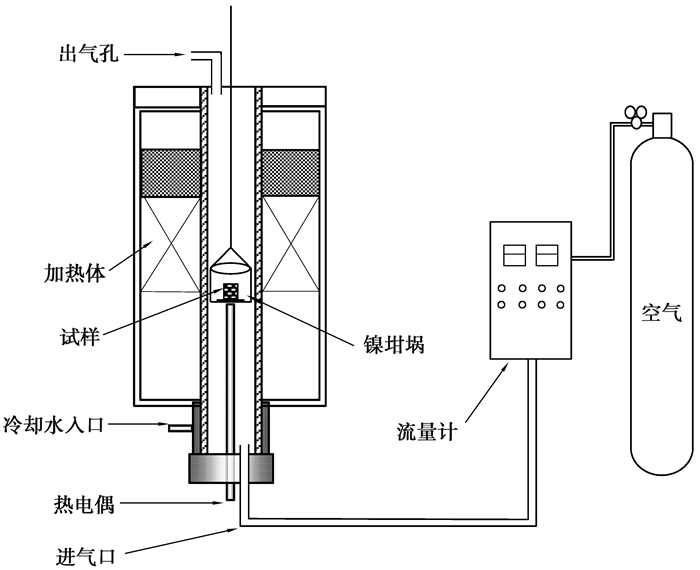
|
图 1 初始液相流动性指数测定装置 Figure 1 Experimental apparatus for measurement of primary melts fluidity index |
将烧结团块置入实验装置中进行焙烧处理,且整个实验在空气气氛下进行,气体流量控制为4 L/min。取出试样测定铺展面积,测定初始液相流动性指数,其计算式[12]为
| I=AtA0−1, |
式中:I为初始液相流动性指数;At为试样流动后的铺展面积,mm2;A0为试样流动前的面积,mm2。
此外,在不同温度条件下,对具有不同Al2O3含量的初始液相进行水淬处理,并采用XRD确定此时初始液相对应的矿物组成,以探究Al2O3含量对初始液相流动性的影响机制。
1.2 Al2O3含量对初始液相微观结构影响初始液相流动的过程中伴随着气泡的重构与聚合行为[13-14]。不同Al2O3含量初始液相流动性的差异性,将会对气孔结构和性能产生作用。将不同条件下焙烧得到的试样进行镶样,经过预磨以及抛光处理后,用光学显微镜对初始液相中气孔结构进行观察。不同条件下气孔结构的研究对象为10个样本,重点分析不同Al2O3含量初始液相中50~100 μm、100~200 μm、大于200 μm的气孔分布,通过图像解析法对气孔的圆度系数以及气孔数目进行研究,确定Al2O3含量增加对于初始液相气孔结构的影响。
2 实验结果与讨论 2.1 Al2O3含量对初始液相流动性影响Al2O3含量对初始液相流动性指数影响的实验结果见图 2。1 210 ℃条件下,低Al2O3初始液相已表现出一定的流动能力,而Al2O3含量为5%和7%的初始液相流动性指数较低。温度升高到1 240 ℃,Al2O3含量为1%的初始液相流动性指数显著提高,而高Al2O3初始液相流动性改善不显著。温度进一步升高至1 270 ℃,高Al2O3初始液相流动性指数有了一定幅度的提高,但其液相流动能力相对于低Al2O3初始液相仍较低。
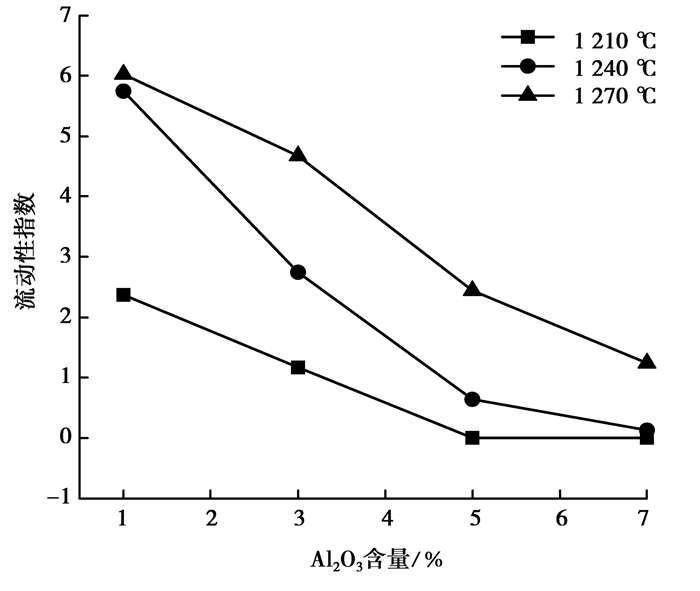
|
图 2 Al2O3含量对初始液相流动性指数影响 Figure 2 Influence of Al2O3 content onprimary melts fluidity index |
为了探究Al2O3含量对初始液相流动性能的影响机理,对不同Al2O3含量的初始液相在不同温度下进行水淬实验,所得XRD实验结果见图 3和图 4。由图 3可知,温度为1 160 ℃时,Al2O3含量为1%的初始液相中已有复合铁酸钙生成。温度升高到1 240 ℃时,复合铁酸钙的衍射峰强度显著减弱,且XRD衍射谱线上出现了液相和磁铁矿的特征,此时对应初始液相的流动性有较大幅度的提高。温度达到1 270 ℃时,XRD谱线的液相特征更为明显,磁铁矿衍射峰强度增强,对应的初始液相流动性指数也进一步提高。
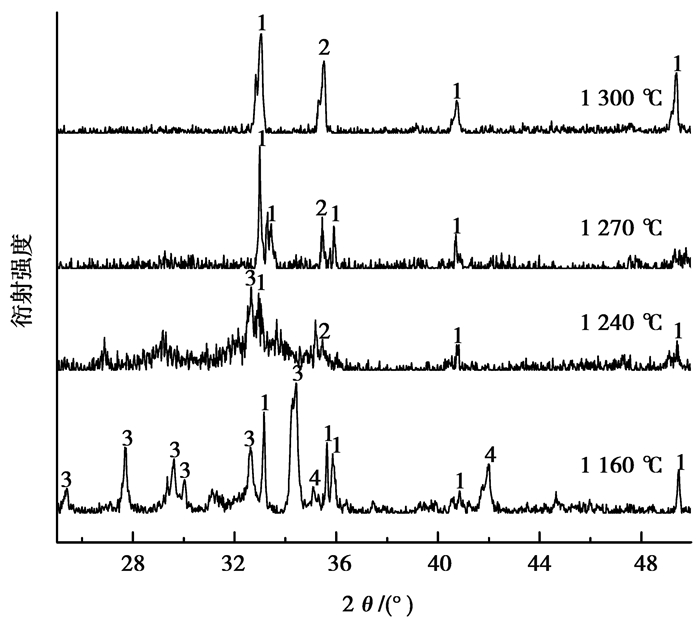
|
图 3 Al2O3含量为1%的初始液相XRD实验结果 Figure 3 XRD results of primary melts with 1% Al2O3 |
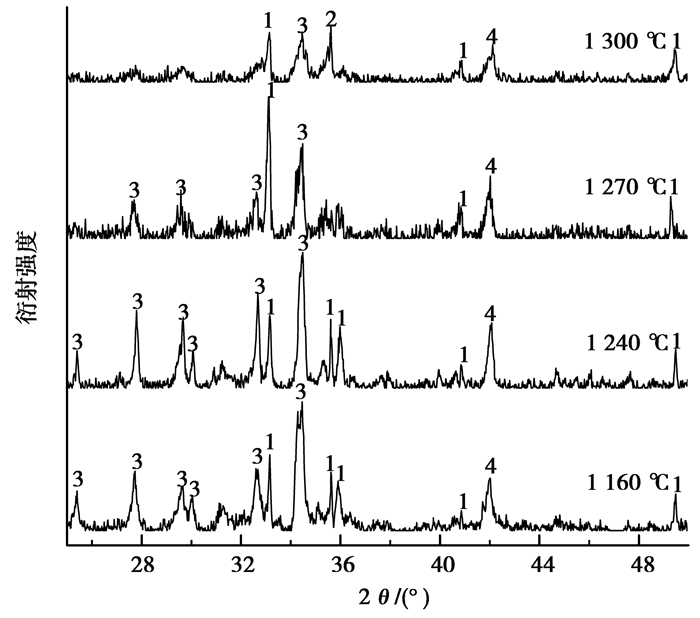
|
图 4 Al2O3含量为5%的初始液相XRD实验结果 Figure 4 XRD results of primary melts with 5% Al2O3 |
对于Al2O3含量为5%的初始液相,1 240 ℃时复合铁酸钙衍射峰强度较大,表明此时复合铁酸钙能稳定存在。温度提高到1 270 ℃时,XRD谱线的复合铁酸钙强度减弱,并开始出现液相特征,对应的初始液相流动性指数提高。到1 300 ℃时,复合铁酸钙强度进一步减弱,液相生成量也随之提高。
研究表明,复合铁酸钙在升温过程中会发生生成磁铁矿和熔盐的分解反应[15],反应式为
| SECA→Fe3O4+Melts. |
上述实验结果表明,初始液相流动性的高低与复合铁酸钙在高温下的分解行为相联系,即与复合铁酸钙的稳定性相关。在Webster[16]的研究中,Al2O3含量由1%分别提高到5%和10%,复合铁酸钙的分解温度分别提高了46 ℃和97 ℃。相同温度条件下,初始液相中Al2O3含量的提高,使得复合铁酸钙的稳定性增强,导致生成的液相量减少和体系过热度的降低,降低了初始液相的流动性。另一方面,从XRD图谱中还能够得出,Al2O3含量的提高也促进了初始液相中铝酸钙等富铝矿物的生成,并在较高温度条件下以固体质点存在。这在一定程度上对硅铝酸盐网络结构的形成具有促进作用,提高了液相的粘度,从而降低了初始液相的流动能力。
2.2 Al2O3含量对初始液相气孔结构的影响图 5为不同Al2O3含量条件下初始液相的光学显微结构。由图可知,不同温度条件下初始液相中的气孔结构有着明显差异性。对气孔孔径分布比例进行解析,所得实验结果如图 6所示。1 210 ℃条件下,随着初始液相中Al2O3含量的提高,尺寸大于200 μm的气孔比例逐渐降低;温度提高到1 250 ℃时,不同Al2O3含量初始液相中50~100 μm的气孔比例均有所降低,而大于200 μm气孔的比例逐渐提高。图 7给出了不同Al2O3含量条件下初始液相中气孔数目。随着Al2O3含量提高,初始液相中尺寸大于200 μm气孔数目有降低的趋势。
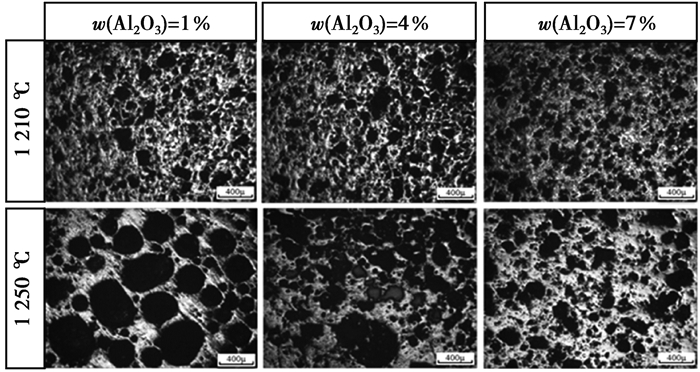
|
图 5 不同Al2O3含量条件下初始液相中的气孔结构 Figure 5 Pore structure of primary melts with varying Al2O3 content |
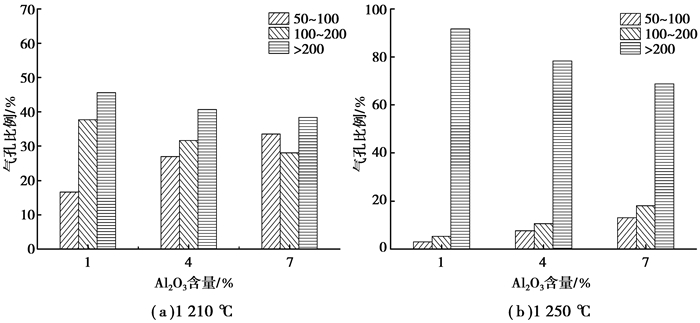
|
图 6 不同条件下Al2O3含量对气孔分布影响 Figure 6 Influence of Al2O3 content on the pore distribution |
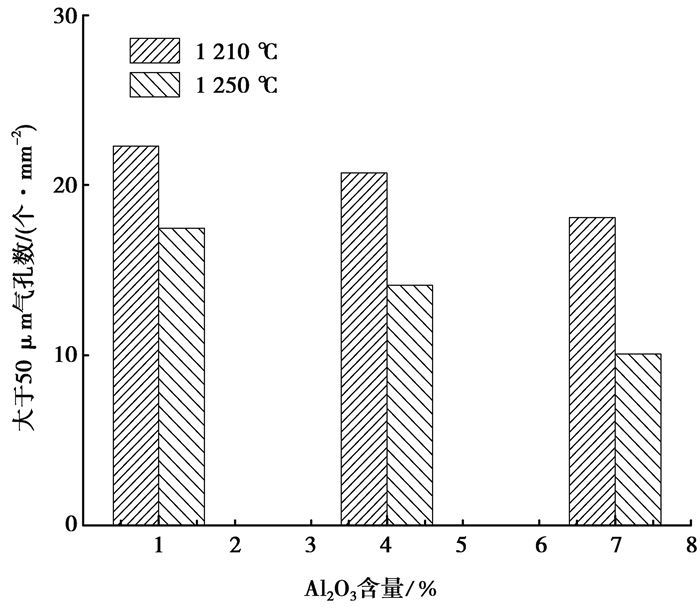
|
图 7 Al2O3含量对初始液相中气孔数目影响 Figure 7 Influence of Al2O3 content onpore number in primary melts |
升温过程中,气泡在初始液相中的行为对气孔分布和数量会产生较大影响[12]。液相在流动过程中,伴随着气泡的重构和聚集的行为。对于气泡来讲,其形态重构的行为要受到其周围物质的影响。对于低温条件下高铝初始液相来讲,由于固相质点和液相同时存在,此时整个体系为非均质体系。在此条件下,液相的表面张力较大,且由于固相质点的存在,气泡重构行为受到抑制。如图 8所示,1 210 ℃时高铝初始液相中气孔形状不规则程度高,圆度系数低的气孔比例较高。此外,由于液相流动能力较差,气泡间难以接触聚合,此时小于50 μm气孔数目较多。但温度提高到1 250 ℃时,改善了液相流动性,也使得高铝初始液相中的气孔圆度有所改善。
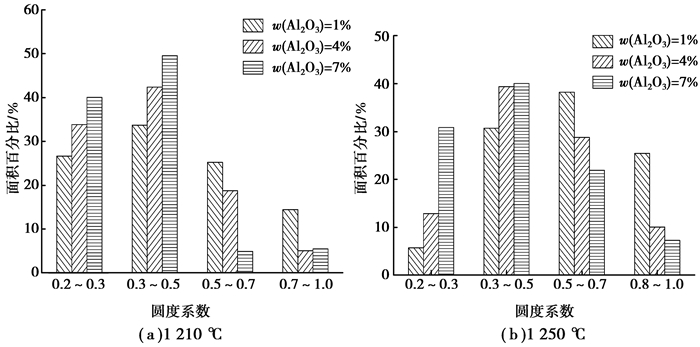
|
图 8 Al2O3含量对初始液相气孔圆度系数影响 Figure 8 Influence of Al2O3 content on the roundness degree of pore in primary melts |
Al2O3含量降低或温度升高时,液相生成量较多,有助于体系过热度的提高[17]。一方面降低了固相质点的数量和液相的表面张力,这使得气泡的重构能力增强,由此得到的气孔形状规则程度较高,圆度系数也随之升高。另一方面,温度的升高也有利于提高液相的流动能力。在液相流动过程中,气泡更容易接触聚合,并向体系外逸出,使得气孔的数目随之减少,气孔尺寸也呈现出增大的趋势。
3 结论1)烧结初始液相的流动性指数随着Al2O3含量的提高而逐渐降低。提高体系温度,有利于高Al2O3初始液相的流动性能的改善。
2)提高Al2O3含量使得提高复合铁酸钙稳定性增强,降低了复合铁酸钙分解生成液相的数量,造成了高铝液相流动性能的降低。
3)随着初始液相Al2O3含量的提高,使得高Al2O3初始液相中气孔形状不规则程度增加,初始液相中小于50 μm气孔数目亦随之升高。
| [1] | Umadevi T, Sah R, Mahapatra P C. Influence of sinter basicity (CaO/SiO2) on low and high alumina iron ore sinter quality[J]. Mineral Processing & Extractive Metallurgy Imm Transactions, 2014, 123: 75–85. |
| [2] |
王筱留. 钢铁冶金学(炼铁部分)[M]. 北京: 冶金工业出版社, 2004.
WANG Xiaoliu. Iron and steel metallurgy (ironmaking part)[M]. Beijing: Metallurgy and Industry Press, 2004. (in Chinese) |
| [3] | Sinha M, Ramna R V, Sinha M, et al. Effect of variation of alumina on the microhardness of iron ore sinter phases[J]. The Iron and Steel Institute of Japan International, 2009, 49(5): 719–721. DOI:10.2355/isijinternational.49.719 |
| [4] | Lu L, Holmes R J, Manuel J R. Effects of alumina on sintering performance of hematite iron ores[J]. The Iron and Steel Institute of Japan International, 2007, 47(3): 349–358. DOI:10.2355/isijinternational.47.349 |
| [5] | Choudhary M K, Bhattacharjee D B, Bannerjee P S, et al. Effect of variation of alumina on development of phases during iron ore sintering[J]. The Iron and Steel Institute of Japan International, 2008, 48(12): 1804–1806. DOI:10.2355/isijinternational.48.1804 |
| [6] | Kimura H, Ogawa T, KakikiM, et al. Effect of Al2O3 and MgO additions on liquidus for the CaO-SiO2-FeOx system at 1 573 K[J]. The Iron and Steel Institute of Japan International, 2005, 45(4): 506–512. DOI:10.2355/isijinternational.45.506 |
| [7] | Jeon J W, Kim S W, Suh I K, et al. Assimilation behavior of quasi-particle comprising high alumina pisoliticore[J]. The Iron and Steel Institute of Japan International, 2014, 54(12): 2713–2270. DOI:10.2355/isijinternational.54.2713 |
| [8] | Eiki K, Wu S H, Yasuo O. Factors governing the strength of agglomerated granules after sintering[J]. The Iron and Steel Institute of Japan International, 1991, 31(1): 17–23. DOI:10.2355/isijinternational.31.17 |
| [9] | Jun O, Kenichi H, Yohzon H, et al. Influence of iron ore characteristics on penetrating behavior of melt into ore layer[J]. The Iron and Steel Institute of Japan International, 2003, 43(9): 1384–1392. DOI:10.2355/isijinternational.43.1384 |
| [10] | HosotaniY, Nakano M. Relationship between the assimilation properties of fine ores and the strength of sinter[J]. Tetsu-to-Hagane, 2003, 89(2): 237–243. |
| [11] | Wu S, Zhang G, Chen S, et al. Influencing factors and effects of assimilation characteristic of iron ores in sintering process[J]. The Iron and Steel Institute of Japan International, 2014, 54(3): 582–588. DOI:10.2355/isijinternational.54.582 |
| [12] |
吴胜利, 杜建新, 马洪斌, 等.
铁矿粉烧结液相流动特性[J]. 北京科技大学学报, 2005, 27(3): 291–293.
WU Shengli, DU Jianxin, MA Hongbin, et al. Iron ore sintering liquid characteristics[J]. Journal of University of Science and Technology Beijing, 2005, 27(3): 291–293. (in Chinese) |
| [13] | Loo C E, Leung W. Factors influencing the bonding phase structure of iron ore sinters[J]. The Iron and Steel Institute of Japan International, 2003, 43(9): 1393–1402. DOI:10.2355/isijinternational.43.1393 |
| [14] | Debrincat D, Loo C E, Hutchens M E. Effect of iron ore particle assimilation on sinter structure[J]. The Iron and Steel Institute of Japan International, 2004, 44(8): 1308–1317. DOI:10.2355/isijinternational.44.1308 |
| [15] | Scarlett N V Y, Pownceby M I, Madsen I C, et al. Reaction sequences in the formation of silico-ferrites of calcium and aluminum in iron ore sinter[J]. Metallurgical and Materials Transactions B, 2004, 35(5): 929–936. DOI:10.1007/s11663-004-0087-4 |
| [16] | Webster N A, Pownceby M, Madsen I C, et al. Silico-ferrite of calcium and aluminum (sfca) iron ore sinter bonding phases:new insights into their formation during heating and cooling[J]. Metallurgical and Materials Transactions B, 2012, 43(6): 1344–1357. DOI:10.1007/s11663-012-9740-5 |
| [17] | Machida S, Nushiro K, Ichikawa K, et al. Experimental evaluation of chemical composition and viscosity of melts during iron ore sintering[J]. The Iron and Steel Institute of Japan International, 2005, 45(4): 513–521. DOI:10.2355/isijinternational.45.513 |
 2015, Vol. 38
2015, Vol. 38



